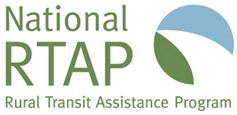RESOURCES > TECHNOLOGY TOOLS
Getting Started | How-to Resources | FAQs & Best Practices | Additional Resources | Other GTFS Data Managers | Upload GTFS Feed
GTFS (General Transit Feed Specification) Builder
Trip planning technology (the integration of transit route and schedule data on a map) enables riders to determine how to use transit to get where they need to go. General Transit Feed Specification, more commonly known as GTFS, is the world standard format for uploading schedule and geographic data (route alignment and bus stops) to trip planners, such as Google Transit, Apple Maps, Bing and Transit App, etc.
In support of the National Transit Database (NTD)
GTFS reporting requirements for fixed and deviated fixed route service, National RTAP is offering
GTFS Office Hours on Thursdays at 1:00-1:30 PM ET. Meet with our instructor, share your screen, and ask questions. Use this
link to join via Zoom – no need to register.
Getting Started
Get started using GTFS Builder by clicking on Download located above in center of the banner.
GTFS Builder “How-to” Resources
| GTFS Builder Guidebook | The GTFS Builder Guidebook provides a simple step by step instructions for entering data into each tab of the ImportExport file and describes how to use the corresponding Schedule Generator file. The Guidebook also includes links to the videos listed below and a checklist which may help to estimate the time to complete each step and track progress. |
|---|---|
| Tutorial Videos | |
| What is GTFS and Should My Agency Proceed? | This first video provides an introduction to GTFS and what GTFS looks like on a published trip plan. It also discusses resources needed to develop GTFS, including software and time, and presents options for developing GTFS files. |
| Trip Planner Licensing Agreements | Understanding trip plan data licensing agreements and what, if any, are the risks are presented. An attorney translates a sample agreement from legalese into English in this video. |
| An Introduction to GTFS Builder (Download and Setup) | This video offers an introduction to National RTAP’s GTFS Builder tool and describes how is it used to develop GTFS data. The video reviews how the application is downloaded from National RTAP’s website and how to set up a folder/workspace on a desktop appropriate for GTFS. Other topics include enabling GTFS Builder macros, common GTFS terminology and where to find comprehensive GTFS resources. The video expands on information provided in Section 1 of the GTFS Builder Guidebook. |
| Agency, Calendar, Calendar_dates, Routes, Fare and Transfer Tabs in the ImportExport File | This video demonstrates how data is entered into each of these tabs. The video supports Sections 2, 3, 4, 5 and 13 of the GTFS Builder Guidebook. |
| Identify Bus Stop Coordinates and Complete the Stops Tab in the ImportExport File | This video demonstrates how bus stop coordinates are established using a combination of Google’s MyMaps and Google Earth Pro. The video also discusses the possibility that agency bus stop coordinates already exist and where they can be found. Once the stops are identified, the video shows how bus stop data is entered into the stops tab. This video supports Sections 6 and 7 of the GTFS Builder Guidebook. |
| Using the Schedules_V3 Tab in the Schedule Generator File to complete the Trips and Stop Times Tabs in the ImportExport File | This video demonstrates how to develop schedule data using GTFS Builder’s Schedule Generator file and then enter that data into the stop_times and trips tabs in the ImportExport file. The video also provides an in-depth explanation of the important distinction between routes and trip groups. The video supports Sections 8 and 9 of the GTFS Builder Guidebook. |
| Feed _info Tab, Exporting, Validating and Hosting GTFS Data | This video demonstrates completing the feed_info tab in the ImportExport file, exporting the data into text files, compressing the data, validating/checking the data, resolving common errors and how to host the data so it can be consuming by a trip planner (for example Google). The video supports Section 12 of the GTFS Builder Guidebook. |
| Creating Trip Group Shapes and Complete the Shapes Tab in the ImportExport File | This video details creating the shape for each trip group using Google’s MyMaps and Google Earth Pro along with entering that data into ImportExport file. A method to check that bus stops are reasonably close to the trip group shape file is also presented. While shapes are optional, riders appreciate seeing the route on the road. The video supports Section 14 of the GTFS Builder Guidebook. |
| Demand Response Services | Until all trip planners allow flexible on-demand services to be published, GTFS Builders offers an easy workaround to ensure these services are seen on trip planners. This video shows how to build a “flex workaround” dataset within the current constraints of “fixed and timed” schedules required by Google and other trip planners. The video supports Section 15 of the GTFS Builder Guidebook. |
| Uploading Data to a Trip Planner (such as Google) | Focused primarily on Google’s trip planner, testing, feed configuration, data visualization, how to request to launch and other relevant topics are covered in this video. This video supports and expands on information offered in Section 16 of the GTFS Builder Guidebook. |
| Keeping GTFS Up to Date | This summary video reviews how to maintain and update GTFS data using previously created GTFS Builder files. |
GTFS FAQs and Best Practices
The Google Transit FAQs will help explain some of the history and context of developing GTFS files.
While National RTAP provides tools, instructions, and some technical support, we cannot geocode your stops, build your route map, or correct files for you on a regular basis.
There are other options if your agency wants to maintain the GTFS data but not prepare all the initial files, or vice versa. A partial list of companies that offer these services are listed below under Other GTFS Data Managers.
Additional Resources
Below are some of the additional resources available in support of GTFS Builder:
- Google Transit Partner Program
- Google Transit FAQs
- General Transit Feed Specifications (GTFS)
- TransitLand Feed Registry
- Sample No-Cost Google License Agreement
- Download Shapes Step by Step Instructions PDF
- Google Transit Sign-Up
- Partnerdash (when logged into Google Transit)
- HEX Color Picker
- Calendar Dates (holidays)
- Feed Validator
- Timezones
Other GTFS Data Managers
If you would rather not build and/or maintain your GTFS data, these vendors offer GTFS services:
- AddTransit
- Arcadis/IBI Group
- GMV Syncromatics
- Giro
- Integrated Transport Planning Ltd
- Mecatran
- Mobilibus
- Moovit
- Optibus/Trillium Solutions
- Passio Technologies
- Radiola
- Transnnovation Inc
- TransLoc
- Trapeze Group
- TripSpark
NOTE: these companies are not endorsed by National RTAP and this is not a comprehensive list. Please do your own research before making a decision or starting procurement.
When writing your contract with these companies, we suggest that you ask that the files be returned to you, in case you want to maintain the data.
Conversely, some agencies have found after building their GTFS data that they are not able to maintain it. For those cases, some companies offer customized and targeted GTFS data support services.
Additional Support
If you have a question or need assistance on a rural or tribal transit topic, contact us at 888-589-6821, info@nationalrtap.org, or start a live chat. We welcome comments and suggestions on National RTAP products as well.
For individual staff email addresses and phone numbers, see the Staff page.
Contact Us
We will get back to you as soon as possible.
Please try again later.

National RTAP offers one-stop shopping for rural and tribal transit technical assistance products and services. Call, email, or chat with us and if we can’t help with your request, we’ll connect you with someone who can!
" National RTAP offers one-stop shopping for rural and tribal transit technical assistance products and services. Call, email, or chat with us and if we can’t help with your request, we’ll connect you with someone who can! "
Robin Phillips, Executive Director
" You go above and beyond and I wanted to let you know that I appreciate it so much and always enjoy my time with you. The presentations give me so much to bring back to my agency and my subrecipients. "
Amy Rast, Public Transit Coordinator Vermont Agency of Transportation (VTrans)
" I always used the CASE (Copy And Steal Everything) method to develop training materials until I discovered RTAP. They give it to you for free. Use it! "
John Filippone, former National RTAP Review Board Chair
" National RTAP provides an essential service to rural and small transit agencies. The products are provided at no cost and help agencies maximize their resources and ensure that their employees are trained in all aspects of passenger service. "
Dan Harrigan, Former National RTAP Review Board Chair
" We were able to deploy online trip planning for Glasgow Transit in less than
90 days using GTFS Builder. Trip planning information displays in a riders'
native language, which supports gencies in travel training and meeting Title VI
mandates. "
Tyler Graham, Regional Transportation Planner Barren River Area Development District
Slide title
" Having a tool like GTFS Builder is really light years ahead of what it used to be at one time in terms of how fast you can put everything together. Our university students really can't imagine transit without it, so I think it's very important for us in terms of attracting that particular demographic. "
Michael Lachman, Transportation Services Manager HAPCAP - Athens Transit
Slide title
" In the past we used proprietary database software that was very challenging, very murky, and hard to update. GTFS Builder is a great opportunity to make this more user-friendly, more readily updatable and it
would enable us to show how to create a GTFS to more of the staff. "
Jaime McKay, Former Manager of Direct Services Center for Mobility Equity
Slide title
" Collaboration is a buzz word these days in the industry. On behalf of our Tribal segment, I appreciate RTAP for making Tribes a partner in industry opportunities. The organization goes over and beyond reaching partners one would not expect in a busy industry such as public transportation. Thank you for your tireless efforts! "
Franklin Akoneto, Comanche Nation
Slide title
"We are so very thankful for all your transportation training materials. Your resources are as valuable as gold!"
Holly Walton, Transportation Assistant Manager, Curative Connections
A program of the Federal Transit Administration administered by the Neponset Valley TMA
National RTAP is committed to making this website accessible to persons with disabilities. If you need assistance accessing any content on our website or need alternative formats for our materials, please contact us at info@nationalrtap.org or 781-404-5020.
by National RTAP |


